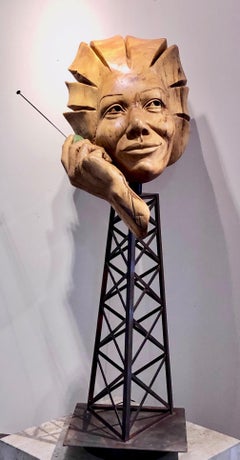Sculpture Cell Phone
2010s Contemporary Figurative Sculptures
Steel
People Also Browsed
21st Century and Contemporary Italian Modern Jewelry Boxes
Ebony
2010s South African Modern Abstract Sculptures
Wood
21st Century and Contemporary Contemporary Portrait Paintings
Oil, Fabric
Vintage 1980s British Art Deco Animal Sculptures
Metal, Gold Plate, Sheet Metal, Gold Leaf
21st Century and Contemporary French Mid-Century Modern Sofas
Stainless Steel
21st Century and Contemporary Danish Mid-Century Modern Sofas
Fabric, Wood
20th Century American Mid-Century Modern Lounge Chairs
Zebra Hide
Mid-20th Century American Brutalist Abstract Sculptures
Granite, Brass, Bronze
1980s Pop Art Figurative Prints
Lithograph, Offset
Vintage 1950s American Brutalist Abstract Sculptures
Metal
2010s French Wall Mirrors
Bronze
Mid-20th Century Papua New Guinean Tribal Tribal Art
Organic Material
Late 20th Century Beninese Folk Art Sculptures and Carvings
Ebony
2010s Contemporary Figurative Sculptures
Bronze
20th Century American Modern Nude Photography
Photographic Paper, Color, C Print, Digital
2010s Romanian Modern Wall-mounted Sculptures
Cast Stone
Sculpture Cell Phone For Sale on 1stDibs
How Much is a Sculpture Cell Phone?
Troy Williams for sale on 1stDibs
Troy Williams is a gifted and dedicated sculptor. He has studied in the United States and Europe, and his work can be found in private collections around the world. A full-time sculptor since the early 80s, Williams feels his most valuable education has come from the experience of sculpting. The subject of his sculpture ranges from inspiring liturgical works to a more abstract sculpture representing moments or beings expressed in human form. Williams has a wide variety of styles that range from the classical representational figures to more stylized figures with suggestive lines and sweeping movement. Although his work ranges in style and subject, they all carry a figurative theme reflecting our deepest nature. Williams's most recent work may be found here and at Glenn Green Galleries.
A Close Look at Contemporary Art
Used to refer to a time rather than an aesthetic, Contemporary art generally describes pieces created after 1970 or being made by living artists anywhere in the world. This immediacy means it encompasses art responding to the present moment through diverse subjects, media and themes. Contemporary painting, sculpture, photography, performance, digital art, video and more frequently includes work that is attempting to reshape current ideas about what art can be, from Felix Gonzalez-Torres’s use of candy to memorialize a lover he lost to AIDS-related complications to Jenny Holzer’s ongoing “Truisms,” a Conceptual series that sees provocative messages printed on billboards, T-shirts, benches and other public places that exist outside of formal exhibitions and the conventional “white cube” of galleries.
Contemporary art has been pushing the boundaries of creative expression for years. Its disruption of the traditional concepts of art are often aiming to engage viewers in complex questions about identity, society and culture. In the latter part of the 20th century, contemporary movements included Land art, in which artists like Robert Smithson and Michael Heizer create large-scale, site-specific sculptures, installations and other works in soil and bodies of water; Sound art, with artists such as Christian Marclay and Susan Philipsz centering art on sonic experiences; and New Media art, in which mass media and digital culture inform the work of artists such as Nam June Paik and Rafaël Rozendaal.
The first decades of the 21st century have seen the growth of Contemporary African art, the revival of figurative painting, the emergence of street art and the rise of NFTs, unique digital artworks that are powered by blockchain technology.
Major Contemporary artists practicing now include Ai Weiwei, Cecily Brown, David Hockney, Yayoi Kusama, Jeff Koons, Takashi Murakami and Kara Walker.
Find a collection of Contemporary prints, photography, paintings, sculptures and other art on 1stDibs.
Finding the Right Figurative-sculptures for You
Figurative sculptures mix reality and imagination, with the most common muse being the human body. Animals are also inspirations for these sculptures, along with forms found in nature.
While figurative sculpture dates back over 35,000 years, the term came into popularity in the 20th century to distinguish it from abstract art. It was aligned with the Expressionist movement in that many of its artists portrayed reality but in a nonnaturalistic and emotional way. In the 1940s, Alberto Giacometti — a Swiss-born artist who was interested in African art, Cubism and Surrealism — created now-iconic representational sculptures of the human figure, and after World War II, figurative sculpture as a movement continued to flourish in Europe.
Lucian Freud and Francis Bacon were some of the leading figurative artists during this period. Artists like Jeff Koons and Maurizio Cattelan propelled the evolution of figurative sculpture into the 21st century.
Figurative sculptures can be whimsical, uncanny and beautiful. Their materials range from stone and wood to metal and delicate ceramics. Even in smaller sizes, the sculptures make bold statements. A bronze sculpture by Salvador Dalí enhances a room; a statuesque bull by Jacques Owczarek depicts strength with its broad chest while its thin legs speak of fragility. Figurative sculptures allow viewers to see what is possible when life is reimagined.
Browse 1stDibs for an extensive collection of figurative sculptures and find the next addition to your collection.
